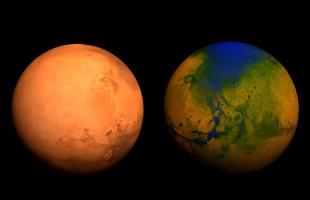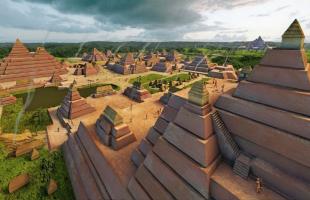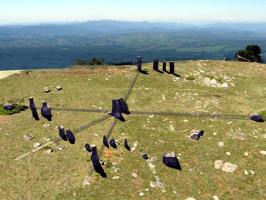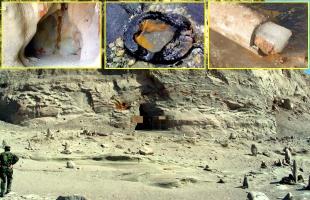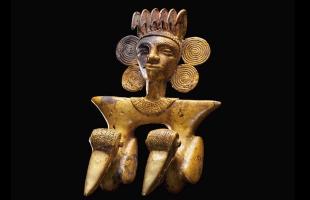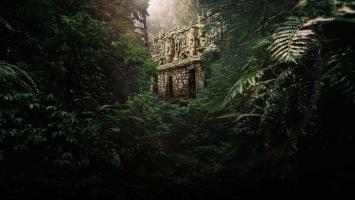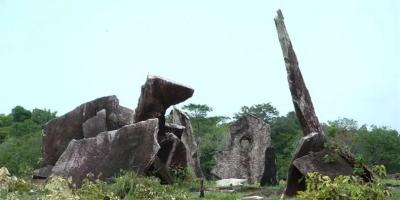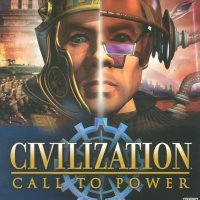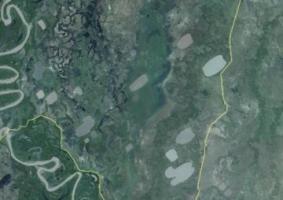The Koma civilization

Geography

Ghana is a west African country located on the Gulf of Guinea, just north of the equator. It shares a border with the Ivory Coast to the west, Togo to the east and Burkina Faso to the north.
Ghana owes its former name, Gold Coast, to the large amount of gold to be found in the country. Before being exploited by the British, German, Dutch and French colonists, this gold was used abundantly by the Ashanti ethnic group, supporting their tradition of splendid gold jewelry, a tradition also propagated by the neighboring Baoulé ethnic group.
The country consists of dense tropical forests in the south, and the savanna in the north. Its tropical climate is extremely rainy, especially in the summer. The Black Volta, the White Volta and the Oti and Daka Rivers join each other in Ghana forming Lake Volta. The Akosombo dam, located to the south of the lake, produces energy for the country.
There are about 21 million inhabitants.
History

In 1984, anthropologists from the University of Münster discovered ancient buerial mounds in the north of Ghana, just south of the border with Burkina-Faso, on the tribal land of the Koma-Bulsa. The discovery would not remain a secret and towards the end of the Eighties, the peasants of the area were searching for and finding small ceramic sculptures, generally of male heads. These sculptures had been bueried in the ground and nobody knew of their origin. Poetically, the peasants called these small 7 to 18 cm sculptures "Kronkronbali", i.e. the children of antan...
The results of thermoluminescence tests indicate that these objects were created between the 13th and the19th centuries. Judging by this time period, they were thus attributed to the ancestors of the modern Koma-Bulsa people, a sub-group of the Mole-Dagbani ethnic group in the north of Ghana.

One can thus consider that the Koma statues are contemporary with the Akan heads also from Ghana and the famous Djenné statues from Mali. Let us recall that the Akan heads have been dated from between the 16th and the 18th centuries, and the Djenné statues from the 9th to the 18th centuries.
It has been only 30 years that the villagers of Komaland have been unearthing these small anthropomorphic or zoomorphic objects whose aesthetic quality has since allured African art experts, specialists in the art market and other treasure hunters, to the detriment of any anthropological study.
Culture
To our knowledge, there is not much literature on the subject of Komaland and not much is known of this enthralling art of African ceramics. The authors who have addressed the topic agree that these statues were for funerary use. According to a report on a meticulous excavation campaign in August 1984, « the funerary practice of burial under a structure of stones arranged in a circle with a pile of other stones and various objects, does not have such sophisticated precedents in Ghana ». According to the research, the terra cotta art from ancient Komaland seems to be the work of traditional qualified craftsmen quite sensitive to aesthetics. This art is, without any doubt, strongly symbolic.

The general shape of these stone cones seems to be that of the male phallus, all the more so when it is put in the ground. The penetration of the phallus into the ground is similar to the act of procreation and symbolizes fertility. The head and the face which remain above ground probably represent the spirits of the ancestors and symbolize either reincarnation, the new life of the deceased, or the spirits who protect him.
The top of the heads is concave, like a bowl. It seems as though the artist pressed the center of the head with his fingers, to dig out a receptacle there. Curiously, this bowl on top of the head is connected to the nostrils by interior passages which gives rise to the thought that these heads were intended to hold liquid offerings, which would drip out of the cranium through the nose, continuing on to the ground.
The same process would occur when it rained, allowing the passage of this natural divine and sacred fluid towards the ground. If it is added that these kinds of funnels in the bottom of the bowls are vagina-shaped, and that the protuberances of the receptacle resemble those of the clitoris, the observer will certainly understand the symbolism of the intention.
The characters themselves are representations of dignitaries, riders or hunters, wearing necklaces, belts and bracelets, and with prominent navels and areolas. Some are only heads, very well worked, with beards, hollowed out nostrils and ears, and sophisticated hairstyles. The majority were found in tombs, the rest on the surface of the ground, sometimes decorated with cowrie shells. Let us not forget that the cowrie shell represents the female genitalia in several West African cultures...
Aesthetics
Certain characteristics of Koma statuary are remanent. Some of the conical terra cotta representations of heads end in a pointed cranium, others in the shape of a mug or short column. Several human figures wear hats decorated with cowrie shells. On other statues, cowrie shells are placed on the mouth, the genitals and on other parts of the body.

The eyes resemble glasses and the ears are like two handles firmly attached to the back of the head. The mouths are generally open, as if the mute characters were singing or speaking. Two non-facial mouths were sometimes joined together to form a new orifice about which we will say no more! Another example of the magic of this statuary: these faces were fused with other faces, to which arms and legs were added. The piece seems to represent an anthropomorphic rebirth. As do these Janus faces which seem to represent a certain social solidarity. And this combination of the two sexes on same object, as described above, can be interpreted as the union of the two sexes, the creation of life, the safeguarding of the species. One might wonder whether the Komaland potters were, in fact, women...
The features are often coarsely marked. The mouth is split horizontally, the eyes, the nose, the eyebrows, and the beard and moustache are generally made from rolls of earth. The top of the head is concave and is hollowed out, allowing the piece to fire properly.
These heads seem to be created as such, without bodies, as in Akan or Anyi statuary. They almost seem like stoppers or corks, or even more like a kind of nail or golf tee, inserted into the ground around a circular buerial mound covered with stones.
More complete statues have been found with a body, often in a seated hieratic position, the hands on the knees. Even more elaborate statues have also been found, in particular some richly adorned riders, on the back of a horse or a camel, which attest to the fortune acquired from commercial activities along the Trans-Saharan roads. Others depict scenes of the everyday life (women nursing, preparing food...), representations of kings or chiefs, slaves, pieces of furniture, or musical instruments; this is certainly a rich collection to supplement the unbounded body of this creative and living art.










